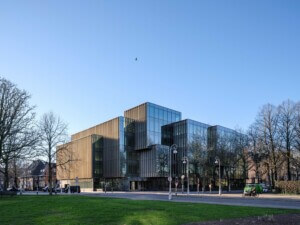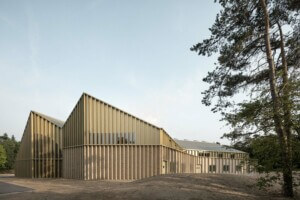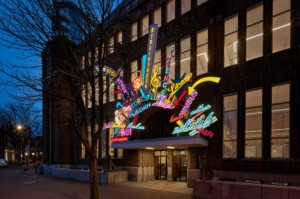Shopping these days is often done online, making street-level urban and suburban commercial retail spaces eerily vacant, but this was not always the case. Consider Rotterdam’s Lijnbaan.
The Lijnbaan, a large-scale development for Rotterdam proposed by Dutch architect Jo van den Broek, was made of housing and commercial buildings. Around 100 shops were built in two phases: the north part was completed in the 1950s, which is now preserved as a rijksmonument (a national heritage site), and the southern arm was done the 1960s and was open to change. Both arms received much publicity for their pedestrian orientation. This urban complex arose on the ruins of a Rotterdam that was bombed on May 14, 1940, by Hitler’s Luftwaffe. Cornelis Van Traa designed the urban plan for the center of the city and instead of following the historic forerunners of the street system, created a new system, precisely for a changed society.
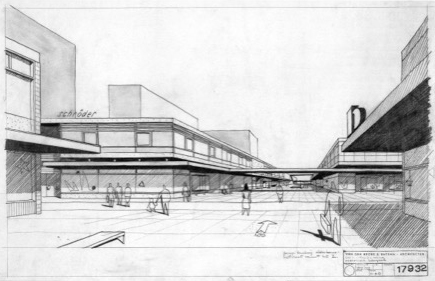
The freshly conceived apartment buildings’ designs were headed by Hugh Maaskant and his associates and, germane for our subject, the handsome “new objectivity” Lijnbaan shops along a mostly “L-Shaped” street system were credited to the architectural firm Van den Broek and Bakema. The main architects were Jaap Bakema and Frans van Gool. The former is the subject of a new book, Dirk Van Den Heuvel’s Jaap Bakema and the Open Society. Bakema gained his reputation for his participation in Team 10 and his large-scale building production. Van Gool designed but also oversaw construction and made stunning perspectives of the shops. However, the authorship of the Lijnbaan quarters is somewhat blurred, since responsibilities were shared by the architects’ offices and city officials, as occurs frequently in many urban projects.
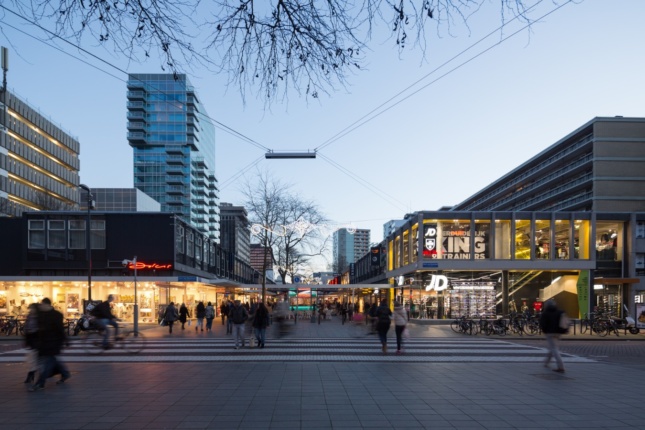
Mostly all the shops, placed in double rows in the 18-meter-wide plan, were built of reinforced concrete frameworks with prefab elements and brick walls filled in. Iconic canopies were made of steel and wood; they protected and ran along most of the shop rows. Also, there were seven lines of canopies that stretched across the landscaped areas that separated the shop rows. These in-between areas were furnished with many attractions; landscaped zones with flowers and trees were accompanied by kiosks and benches. Delightful for strollers, they now suffer from wear.
While the southern arm of the complex is in turmoil, the northern part is being restored by Robert Wankel of Mei Architects. Most notable is their restoration of the Lijnbaan 77 on the corner of the Aert van Nesstraat. Working under the auspices of an area regulation pact, “Lijnbaanregeerakkoord,” Mei Architects have given the frayed parts of the canopies sensitively treated materials in accord with the preexisting concrete and wood. Even more recent is the work of Kees Kaan who has designed the Schaap en Citroen jewelers and fashion retailer COS shop on the corner of Karel Doormanstraat 278. Formerly Martin’s Tearoom, its 3-story corner block is incompatible with other 2-story Lijnbaan shops. Yet, it is tame in comparison with the towering blocks proposed nearby.

The southern arm of the Lijnbaan, which is not eligible for 50-year preservation status, is being threatened by moneyed interests and a high powered designer, Rem Koolhaas, and his firm, OMA. Commerce is vital, but when it drowns out human values it needs to be upended. Multi Nederland is the developer and the “star” architect is Rem Koolhaas—former supporter of the social values of shopping and the preservation of historical modern buildings. Developer and architect have bowed to the expedient forces and designed an ugly tower complex (maybe they think it’s delirious). Koolhaas and Reinier de Graaf, OMA’s partner in charge, ignore the unified low-rise nature of the Lijnbaan shops. It is all very cynical as Dirk van den Heuvel, says—the city needs the money and automatically forgets the prize-making history of the Lijnbaan, the jewel of postwar Rotterdam’s modernist ideals.
As the great urban historian, Lewis Mumford, pointed out, the shopping experience for pedestrians is of great importance. The anti-preservation forces even include Wessel de Jonge, co-founder of the Docomomo organization which purports to preserve endangered modern architecture. Demolition work has already begun on badly maintained shops, so the tragic end may be near.








